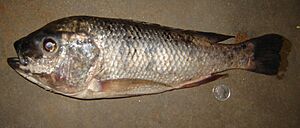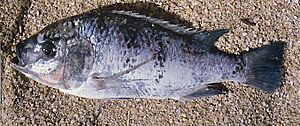Oreochromis lidole facts for kids
Quick facts for kids Oreochromis lidole |
|
|---|---|
 |
|
| An emaciated female fish from Malembo, Lake Malawi | |
 |
|
| A young fish from Cape Maclear, Lake Malawi | |
| Conservation status | |
| Scientific classification | |
| Synonyms | |
|
The Oreochromis lidole is a type of freshwater fish that belongs to the Cichlidae family. This fish is a kind of tilapia. It naturally lives in Malawi, Mozambique, and Tanzania. You can find it in Lake Malawi, Lake Malombe, and the Shire River. It might also live in some crater lakes further north.
This fish is important for fishing. However, its numbers have dropped a lot. It might even be extinct now. This fish is also known as chambo. This name is also used for two other similar fish in the same area: O. karongae and O. squamipinnis.
Contents
What's in a Name?
A British ichthyologist named Ethelwynn Trewavas first described this fish in 1941. She called it Tilapia lidole. She found the fish during a survey of Lake Malawi in 1939. The name 'dole' came from a local name for the fish. People also called it galamula or lolo. The general name chambo was used for it and other similar tilapia species.
Later, in 1976, this fish was moved to the genus Sarotherodon. This happened along with other tilapia that carry their young in their mouths. Then, it was moved again into the genus Oreochromis. This group includes fish that show clear sexual dimorphism. This means males and females look different in size, shape, or color. It has also been part of the subgenus Nyasalapia.
How to Spot an Oreochromis lidole
Young chambo fish all look very similar. But you can tell them apart from other fish. They have a silver body and vertical stripes that get thinner. They also have a 'tilapia spot' on their lower dorsal fin.
Oreochromis lidole can be told apart from other chambo species when they are about 17–20 cm (6.7–7.9 in) long. They usually look like they have a big head and a thin body. This is because their body is not as deep. They also have a larger mouth and bigger gill-covers. Their jaw teeth are in 3-4 clear, separate rows. Other species often have teeth in more regular rows.
During breeding season, males turn very black. Their fins have white edges. This is similar to O. karongae. But it helps tell them apart from O. squamipinnis.
Reproduction and Life Cycle
Like all other Oreochromis fish, O. lidole is a maternal mouthbrooder. This means the female fish carries her eggs and young fish in her mouth. She does this for several weeks. When the young fish have used up their yolk sacs, they leave her mouth to find food. The mother still watches over them. If there is danger, they can swim back into her mouth.
Females can produce up to 700 young. They have been seen guarding young fish up to 5 cm (2.0 in) long. Breeding mostly happens during the hot season, from October to January. Males gather in deep water, usually 20–45 m (66–148 ft) deep. They go to clean, steeply sloped beaches. There, they dig huge craters, about 1–3 m (3 ft 3 in – 9 ft 10 in) wide. This is where they court and lay eggs. Females often travel to murky waters with more food. They do this to release their young, for example, in Lake Malombe.
What They Eat
Oreochromis lidole mainly eats plankton. This includes tiny crustaceans like Bosmina and Diaptomus. They also eat diatoms such as Aulacoseira and Surirella. Other larger algae are also part of their diet.
Where They Live
Oreochromis lidole has been found all over Lake Malawi. They tend to live in deeper areas that are less muddy. Other chambo species often live there too. They are sometimes caught together by fishermen. This suggests they might swim in groups. Like other chambo, they are rarely caught deeper than about 50 m.
Young fish and females carrying young often stay in shallower, muddier water. Places like Lake Malombe are good for them. This fish was reportedly most common in the southern parts of the lake where there is a lot of food. It was rare near muddy or rocky coasts.
Why They Are Disappearing
Oreochromis lidole used to be an important food fish in Lake Malawi. Many were caught by fishing boats in the South Eastern Arm near Maldeco. A study by Turner showed that the populations of all chambo species dropped a lot in the 1990s.
For example, in one part of Lake Malawi, the amount of chambo caught by a boat each day fell from 70 kg (150 lb) to 4.5 kg (9.9 lb) between 2006 and 2016. Even though hundreds of chambo are caught daily, no one has officially identified any as O. lidole since 1992. Because of this, the IUCN (International Union for Conservation of Nature) said in 2016 that no one knows for sure if O. lidole is still alive. They declared that it might already be extinct.


